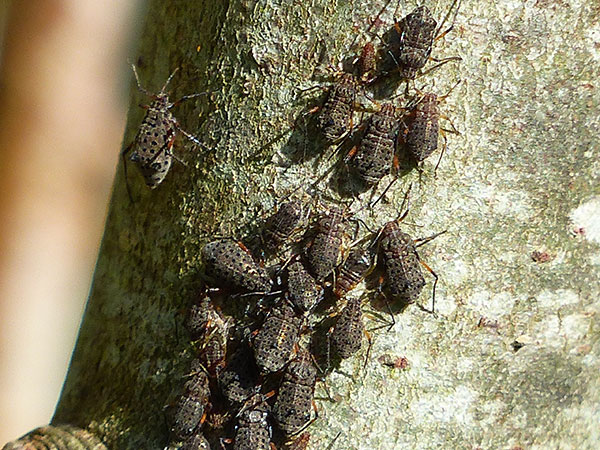Giant Willow Aphid causing concern
Posted on July 18, 2016

The giant willow aphid has persisted in high numbers around New Zealand thanks to the mild start to winter.
“In the last two seasons giant willow aphid populations have fallen off much earlier. We could do with a run of frosts to reduce numbers,” says Ian McIvor, general manager of the Poplar and Willow Research Trust.
“But we have had reports of aphids in Southland in early July after an initial discovery in the summer and also in trees other than willows. Both of these new twists are of great concern. This season has seen GWA extend its range throughout the country and extend its active period by around two months. It is having a devastating effect.”
The giant willow aphid, which measures 5-6mm, was first sighted and reported in Auckland in December 2013 and quickly spread throughout the North Island and as far south as Clyde in Central Otago. Willows are its only recognised host plant. It taps into the sugar flow in the stem and the pressure of sap through the aphid produces honey dew.
Higher than normal numbers of wasps are likely indicators of aphid infestation as they feed on the honey dew. Bees also harvest the honey dew, which can change the characteristics of their honey including raising its melting temperature and causing discolouration. It is difficult not to miss the sight of blackened willows along the rivers. The blackening is sooty mould, which feeds on the honeydew deposited on leaves and branches by the feeding aphids and leaves black on the top of the willow branches and leaves.
“I expect the sooty mould will die and flake off the willows during winter,” McIvor says. “There is no evidence it harms the tree but we’ve not seen it this extensive… we’ve not seen the giant willow aphid so active for such a long period of time.”
The giant willow aphid was found in a decorative willow in public gardens in Invercargill last summer, but has since also been found in two places in the past month, says Environment Southland Catchment Manager Noel Hinton, who is also a trustee for the Poplar and Willow Research Trust.
“Some were found in Riverton on Japanese fodder willows and basket willows and more on pussy willows just outside Invercargill,” he says.
“We haven’t identified it on any of our river protection willows but one has to assume because it’s here, it will find its way to the tree it likes to inhabit. Like the rest of the country, it is a worry for us because of the reliance we place on willow for soil stability or erosion control around our river systems. If it impacts the viability of those trees, we have to be concerned.”
He says a few hard frosts recently may have made a difference to numbers but it is a case of watching and waiting.
Plant and Food Research scientist Dave Rogers, Havelock North, says they were alerted to the aphids on apple trees by a Hastings orchardist.
“They were in areas near willows and willow shelter but it was a surprise to see them actively feeding on the apple trees. We plan to see how they are over winter to see if they continue their life cycle there or abandon ship.”
Pipfruit NZ technical manager Tim Herman says apple trees have been known to host the giant willow aphid in Chile.
“The fact there’s not much information about that on the internet suggests it isn’t much of an issue. We will be monitoring the situation and will advise orchardists if they need to act on any isolated infestations.”
McIvor urges landowners to continue to plant willows despite the giant willow aphid. “We just have to find ways of reducing the pest impact on the willows.” He says a field experiment led by Horizons Regional Council’s Grant McLaren to gather evidence on the aphid’s effect on willow growth and general health will be continued for another year.
The National Beekeepers Association is resubmitting a proposal to the Sustainable Farming Fund in their 2016 round to investigate biological controls for the aphid, willow tolerance to the pest and its effect on honey quality.
He says it is hoped to identify, evaluate and possibly import biocontrol agents from Japan.
“We also have Dr Trevor Jones, a scientist working with the Poplar and Willow Research Trust, visiting with scientists in Japan this month who have some knowledge and experience of parasitoids of the giant willow aphid. In the coming months Scion scientist Stephanie Sopow expects to apply to the Environmental Protection Agency for authority to import one particular parasitoid of giant willow aphid into their containment facility for host testing.”
McIvor says a new ladybird, the Harlequin, was identified in New Zealand last summer feeding on the giant willow aphid.
“But that’s a mixed blessing as it is also a predator of native ladybirds.”
For more information please contact Ian McIvor on ian.mcivor@plantandfood.co.nz.
More information: Fact sheet on the giant willow aphid
Photo credit: Lloyd Esler